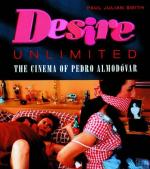|
This section contains 8,532 words (approx. 29 pages at 300 words per page) |

|
SOURCE: "Almodóvar's City of Desire," in Quarterly Review of Film and Literature, Vol. 13, No. 4, 1991, pp. 47-65.
In the following essay, D'Lugo discusses the image of Madrid and Spain's past and present in Almodóvar's films.
History and Desire
Madrid has figured prominently in Pedro Almodóvar's cinema, gradually coming into focus as the implicit protagonist of nearly every work. In these films, the city is regularly imaged as a cultural force, producing forms of expression and action that challenge traditional values by tearing down and rebuilding the moral institutions of Spanish life: the family, the Church, and the law.
Inspired by the conventions of cinematic representation of the city in film and, most pointedly, American filmic depictions of urban space, Almodóvar's city-scapes succeed in imitating the American cinema's unself-conscious universalization of particular milieus as the natural mise-en-scène of action. In the context of a cinema...
|
This section contains 8,532 words (approx. 29 pages at 300 words per page) |

|


